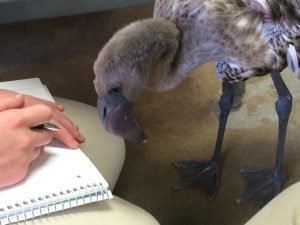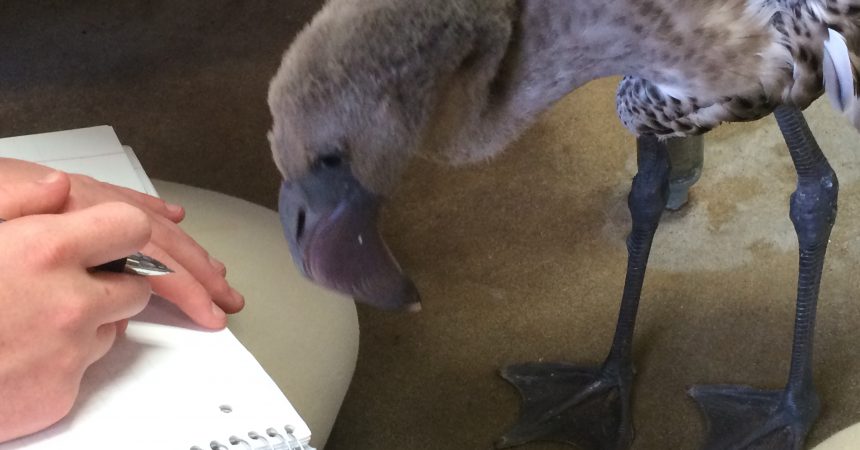Zoo InternQuest is a seven-week career exploration program for San Diego County high school juniors and seniors. Students have the unique opportunity to meet professionals working for the San Diego Zoo, Safari Park, and Institute for Conservation Research, learn about their jobs, and then blog about their experience online. Follow their adventures here on the Zoo’s website!
 Have you ever wondered where the San Diego Zoo breeds its birds? If the answer is “yes”, then this is your lucky day because in this week’s blog, I am going talk about the Avian Propagation Center, but with a conservation twist. For those of you who don’t know, wildlife conservation is the process of preserving all aspects of living creatures from the smallest mouse to the tallest giraffe. Conservation of earth’s feathery friends is extremely important not only for the birds, but also for people.
Have you ever wondered where the San Diego Zoo breeds its birds? If the answer is “yes”, then this is your lucky day because in this week’s blog, I am going talk about the Avian Propagation Center, but with a conservation twist. For those of you who don’t know, wildlife conservation is the process of preserving all aspects of living creatures from the smallest mouse to the tallest giraffe. Conservation of earth’s feathery friends is extremely important not only for the birds, but also for people.
In order to get a closer look into bird conservation, interns met with Ann Knutson, a senior keeper of the Bird Department. Ms. Knutson received a general biology degree at University of California, San Diego. After graduation, she acquired an internship at a zoo in Texas, followed by a job in Kenya researching various birds. Eventually, through networking at the Association of Zoos and Aquariums annual conference, she took a job with the San Diego Zoo. Ms. Knutson currently works with vultures, hornbills, finches, flamingos, and a handful of other birds for educational purposes.
One of the many conservation projects that Ms. Knutson has been involved with is the Egyptian vulture crisis. In order to provide some background information, Ms. Knutson explained a previous vulture crisis, the Asian vulture epidemic. Many people in Asia believed that vultures were so ugly that they couldn’t possibly serve any purpose. Many vultures were harmed due to this widely held belief. With the vulture population severely diminished, house pets were eating the carrion, or rotting meat, normally consumed by the vultures and getting rabies as a result. Realizing their mistake, Asia is diligently working to bring back the vulture population.
The Egyptian vultures face the same struggles as their Asian cousins, but with an additional threat of poaching. It’s not that the hunters are specifically poaching the vultures, but when a vulture flies over a poached carcass on protected land, it can lead the park security to arrest the poachers. In order to prevent the vultures from giving away their position, poachers often shoot down the vultures. Many researchers are already trying to solve this issue, in part by making the global community aware of this issue. But how do they communicate it to the public? This is where Ms. Knutson comes in. She can communicate the information to the public through animal ambassadors. By giving presentations of these birds, she can communicate the problems that the Egyptian vulture and many other birds are facing in the wild.
In addition, to raising birds for educational purposes, Ms. Knutson also raises birds for the protection and preservation of their species. Many of the young birds cared for in the Avian Propagation Center suffer from parental neglect, illness, injury or threats from their environment. For example, interns were introduced to a pair of lesser flamingos from the Safari Park who needed to be hand raised due to local barn owls in the area. The lesser flamingo is an endangered species of flamingo, so it is very important to preserve and protect them. After they have matured enough, the pair will be returned to the flamboyance of flamingos at the Safari Park.
So, you might be wondering what you can do to help. The best thing is to share this information with friends and family. Spread the word so that we can still have these beautiful birds in the wild in the future. Also, do your homework. Research some of these endangered species of birds for yourself, so you can have a solid understanding of what’s happening to these birds and what you can do to preserve species worldwide.
Keith, Conservation Team
Week Three, Fall Session 2016


